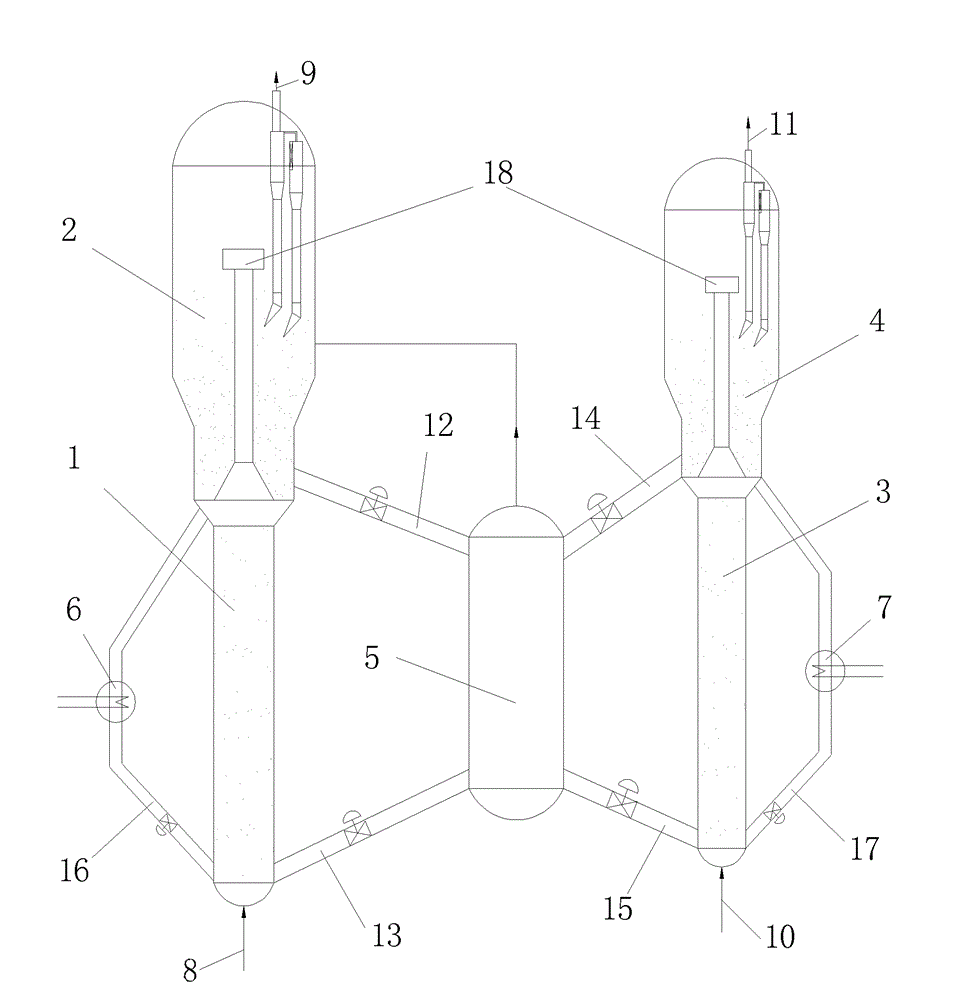Method for producing low-carbon olefins by converting oxygen-containing compounds
A technology of low-carbon olefins and compounds, which is applied in the field of conversion of oxygen-containing compounds to low-carbon olefins, can solve the problems of uneven mixing of catalysts and low yield of low-carbon olefins, and achieve uniform distribution of catalyst carbon deposits, increase yield, and shrink effect of size
- Summary
- Abstract
- Description
- Claims
- Application Information
AI Technical Summary
Problems solved by technology
Method used
Image
Examples
Embodiment 1
[0016] in such as figure 1 In the reaction device shown, both the reactor and the regenerator adopt a fast fluidized bed, and the mixer adopts a bubbling bed. The reaction temperature is 450°C, the regeneration temperature is 650°C, the reaction and regeneration pressures are both 0.01MPa by gauge pressure, the raw material is methanol, the regeneration medium is air, the stripping medium and the fluidizing medium of the mixer are both water vapor. Control the amount of coke deposited on the raw catalyst to be about 5.9% (percentage by weight), and the amount of carbon deposited on the regenerated catalyst to be about 0.5% (percentage by weight). The analysis of the carbon content on the catalyst adopts an infrared carbon-sulfur high-speed analyzer. The raw catalyst in the reaction settler is controlled as the first part by mass flow ratio: the second part=20:1, and the regenerated catalyst in the regenerated settler is degassed and then controlled by the mass flow ratio as th...
Embodiment 2
[0018] in such as figure 1 In the reaction device shown, both the reactor and the regenerator adopt a fast fluidized bed, and the mixer adopts a bubbling bed. The reaction temperature is 450°C, the regeneration temperature is 650°C, the reaction and regeneration pressures are both 0.01MPa by gauge pressure, the raw material is methanol, the regeneration medium is air, the stripping medium and the fluidizing medium of the mixer are both water vapor. Control the amount of coke deposited on the raw catalyst to be about 5.9% (percentage by weight), and the amount of carbon deposited on the regenerated catalyst to be about 0.5% (percentage by weight). The analysis of the carbon content on the catalyst adopts an infrared carbon-sulfur high-speed analyzer. The raw catalyst in the reaction settler is controlled as the first part by mass flow ratio: the second part = 50: 1, and the regenerated catalyst in the regenerated settler is degassed and then controlled by the mass flow ratio as...
Embodiment 3
[0020] in such as figure 1In the reaction device shown, both the reactor and the regenerator adopt a fast fluidized bed, and the mixer adopts a bubbling bed. The reaction temperature is 450°C, the regeneration temperature is 650°C, the reaction and regeneration pressures are both 0.01MPa by gauge pressure, the raw material is methanol, the regeneration medium is air, the stripping medium and the fluidizing medium of the mixer are both water vapor. The carbon deposition mass fraction of the ungenerated catalyst is controlled to be about 5.9%, and the carbon deposition mass fraction of the regenerated catalyst is about 0.5%. The carbon content on the catalyst is analyzed by an infrared carbon-sulfur high-speed analyzer. The raw catalyst in the reaction settler is controlled as the first part by mass flow ratio: the second part = 0.1: 1, and the regenerated catalyst in the regenerated settler is controlled as the first part by mass flow ratio after degassing: the second part = 0....
PUM
 Login to View More
Login to View More Abstract
Description
Claims
Application Information
 Login to View More
Login to View More - R&D
- Intellectual Property
- Life Sciences
- Materials
- Tech Scout
- Unparalleled Data Quality
- Higher Quality Content
- 60% Fewer Hallucinations
Browse by: Latest US Patents, China's latest patents, Technical Efficacy Thesaurus, Application Domain, Technology Topic, Popular Technical Reports.
© 2025 PatSnap. All rights reserved.Legal|Privacy policy|Modern Slavery Act Transparency Statement|Sitemap|About US| Contact US: help@patsnap.com

